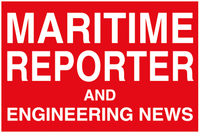
Page 43: of Maritime Reporter Magazine (June 2025)
Read this page in Pdf, Flash or Html5 edition of June 2025 Maritime Reporter Magazine
and amendments are forthcoming as the support our long-term battle to build A U.S. built MR 2 product tanker, legislation eventually hits the Commit- globally competitive U.S. shipbuilding. entering into this operating agreement tees and Senate ? oor and the ACT either We can continue with the fact that that and capable of carrying military cargo passes or fails. the U.S. repair yards are not supported AND holding coastwise privileges
Taking a deep dive into the 300 pag- in the legislation. It is a well-known fact would be more valuable than its for- es of legislative language is enough to in U.S. shipbuilding that “repairs” pay eign counterpart. A trade enhancement return you to the Rip Van Winkle nap the bills and keeps your work force em- that would have stirred US investment and at times we wonder who will actu- ployed. The Ships Act trades that away. in that vessel type. Imagine a U.S. built ally read through all of the provisions. According to a summary provided by tanker being more valuable commer-
There has been legal analysis provided Senator Kelly’s of? ce the ? eet is com- cially simply because the foreign built by a Washington based law ? rm that prised of “commercially viable, militar- or re? ag tanker cannot trade the coasts. is well respected and as a company we ily useful, privately owned vessels.” Let’s remember, the absence of domes- know them well. There is no doubt any What the summary fails to present tic tanker tonnage is the current price owning company or private investment is the bureaucratic operating restric- indication to build and the lack of grav- group looking to support the legisla- tions, competitive analysis and approval ing dock space to build it.
tion will require an enormous education “checklist” the asset needs to pass in And how does that “competitive anal- from counsel if and when they look to order to enter the program or for that ysis” work? Is the existing ATB with a build or purchase tonnage. matter “compete” on a global basis. nine-man crew more competitive than
It is a big “IF”. Unfortunately, it is dif? cult to provide the tanker providing 21 NEW U.S. crew
Our opinion is simply a view from a full excerpt from each section. Only member positions? Is the fact that the mariners on the deck plates and build- a snapshot of language can be provided tanker carries more cargo and deliv- ers & shipyard workers on the drydocks within our short editorial. ers an ef? cient voyage schedule than a with hope that the effort will lead to U.S. tug & barge? Or the fact that the tanker investment in American Shipyards. As Section 53603 – pages 87-88: ‘‘(B) can be built to meet California CARB of today, ours and others in the ? nancial Beginning on the ? rst day of the regulations and IMO MEPC emissions markets, is simple, the business model operating agreement, the vessel and our existing domestic “ATB tanker” numbers don’t work. And that is a non- will be permanently ineligible for ? eet does not? starter for rebuilding our maritime base. a coastwise endorsement 26 under
The ACT creates “The Strategic Com- section 12112 of this title or to oth- Size – & Cargo – Matter mercial Fleet Program”, a U.S. ? ag ? eet erwise participate in the coastwise In 1972, the vessel Tokyo Bay was re- of 250 ships developed over a period of trade, even if the operating agree- ported as the largest container ship built 10 years. Industry has questioned the ment is terminated or not renewed. in Japan at 2,300 TEU. The Matson Alo- intent of the legislation simply asking ha Class container vessels scheduled to what type of ships would be built. The Title V pages 180 – 182 ‘‘(f) PILOT be built at Hanwha Shipyard are listed program and operating agreements favor PROGRAM FOR VESSELS IN as the largest U.S ? ag-built container foreign “re? ag” and more or less wraps DOMESTIC COMMERCE a ves- ships in 2026 at 3,400 TEU. China and
MSP and TSP into a new-seven-year sel qualifying for funding through Korea are building 24,000 TEU vessels. operating agreement with the “approved the pilot program under this sub- This should be an interesting “competi- tonnage”. The USCG re? ag require- section shall only be eligible if the tive analysis” discussion for this vessel ments were recently “relaxed” again Administrator certi? es that the ves- type as the vessels are also “military this month to reduce ? ag costs in a for- sel of the United States that will be useful”. The enormous cost differen- eign build. Another indication a re? ag constructed— ‘‘(A)(i) will operate tial of the build at Hanwha, recently re- path will be the road taken towards the in an emerging industry or a new ported as “climbing” would again place 250 number. Before we continue, the in- trade lane; ‘‘(ii) will not compete further investment in jeopardy. dustry excitement and fanfare are based with existing vessels of the United U.S. investment would look to build upon “rebuilding and revitalizing” our States; and ‘‘(iii) will not serve a 1000 TEU to 5000 TEU Container feed-
U.S. Shipyard base. That is where the market already served by a vessel ers to support the requests from the larg- jobs and manufacturing base is created. of the United States with a coast- er U.S. container ports to assist in port
Re-introducing a re? ag commitment is wise endorsement; congestion mitigation. Global container a double-edged sword. And it does not operators have also looked to develop www.marinelink.com 43
MR #6 (34-45).indd 43 MR #6 (34-45).indd 43 5/31/2025 7:57:03 PM5/31/2025 7:57:03 PM

 42
42

 44
44
